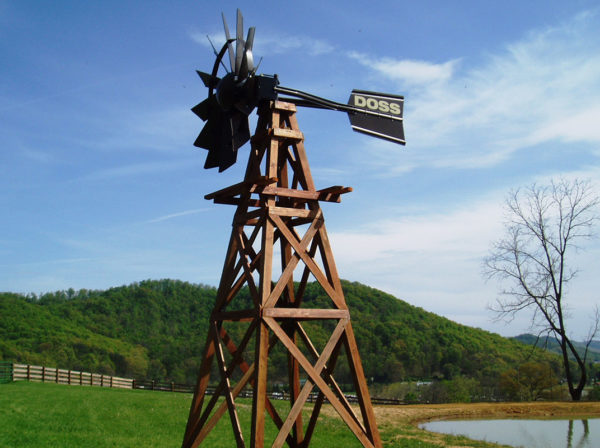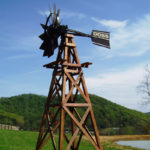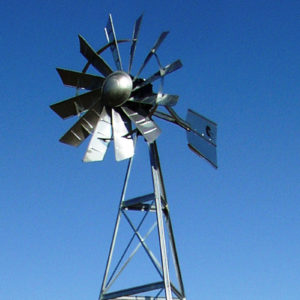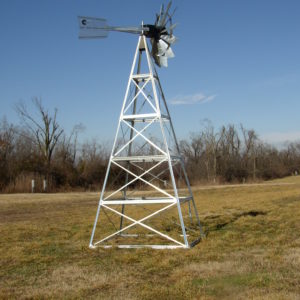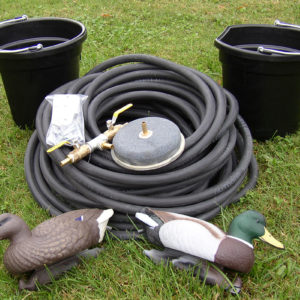Description
16′ Powder Coated Wood Aeration Windmill – 4-Legged
Want a more Nostalgic look and feel? Our new 16′ Powder Coated Wood Aeration Windmill – 4-Legged are a masterpiece in design.
Manufactured in the U.S. with a light cedar-colored pressure treated wood, 16′ Powder Coated Wood Aeration Windmill – 4-Legged will look great for a long time! Assembled height of the windmill and head is 19′.
Functional Windmill Aeration system comes with the wooden tower, a functional compressor with our patent-pending BalCam II technology, and a 5-year warranty.
Accessories for the 16′ Powder Coated Wood Aeration Windmill – 4-Legged include:
- 73″ Outdoor Water Solutions Windmill Head
- 16′ Wood Tower Kit
- 100′ of 1/2″ Polytubing
- 50′ of 1/2″ Weighted Airline
- An Airstone Housing Bucket
- 1 Duck Decoy Marker
- 1 Airstone with Backflow Valve
The blade diameter on all units is a full 73″ in diameter, which is the largest windmill head on the market for pond aeration. The massive 73″ head is designed to turn in even low wind situations. Plus, the front dome and blade have been recently redesigned for better airflow. This keeps your pond or lake aerated even on those warm, calm summer days. This allows our units to pump up to 4.5 CFM of air and still turn at low wind speeds due to our windmill heads’ higher torque. We can also produce up to 30 psi of air allowing these units to aerate ponds or lakes that are 10′, 20′ or even 30′ deep.
NOTE: The wood that is shipped has been cut to a precise template, but due to environmental conditions, over the time it takes to pack and ship, it can change slightly. This is due to temperature and humidity variations which can influence the shape of wood and can cause some variation in particular boards. See additional comments below.
Wood – How Temperature and Humidity Shape Its Behavior
Wood, a timeless material, has been a cornerstone of human construction and artistry for millennia. Its natural beauty, strength, and versatility make it a preferred choice for a wide array of applications, from building homes to crafting furniture and art. However, one of the most intriguing aspects of wood is its responsiveness to environmental conditions, particularly temperature and humidity. These factors cause wood to bend, warp, and fluctuate over time, a phenomenon that can be both a challenge and a charm in woodworking.
The Anatomy of Wood and Its Responsiveness
To understand why wood behaves the way it does, it’s essential to delve into its structure. Wood is a hygroscopic material, meaning it absorbs and releases moisture from the air. This process is influenced by the wood’s cell structure, which includes cellulose fibers, hemicellulose, and lignin. These components form a network of cells that can expand and contract with changes in moisture content.
When the humidity level in the air increases, wood absorbs moisture, causing it to swell. Conversely, when the humidity decreases, wood releases moisture and shrinks. This expansion and contraction can lead to warping, cupping, and bowing, which are common challenges in woodworking and construction.
The Impact of Temperature and Humidity
Temperature plays a significant role in wood’s behavior, but it is often the interaction between temperature and humidity that causes noticeable changes. Higher temperatures can increase the rate at which wood absorbs or loses moisture, exacerbating the effects of humidity. For instance, during a hot, humid summer, wood is more likely to expand, while in a dry, cold winter, it tends to contract.
Humidity levels have a more direct impact. Wood tends to reach equilibrium moisture content (EMC), where the wood’s moisture level balances with the surrounding air. If the air is humid, the EMC will be higher, leading to more absorption and swelling. In dry conditions, the EMC drops, resulting in moisture loss and shrinkage.

